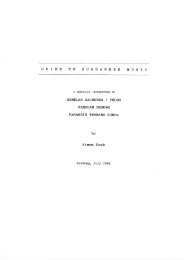Wet rice cultivation in Indonesia - Free EBooks Library
Wet rice cultivation in Indonesia - Free EBooks Library
Wet rice cultivation in Indonesia - Free EBooks Library
Create successful ePaper yourself
Turn your PDF publications into a flip-book with our unique Google optimized e-Paper software.
<strong>Wet</strong> <strong>rice</strong> <strong>cultivation</strong> <strong>in</strong> <strong>Indonesia</strong> Chapter seven<br />
The second sub question considers the impact that the identity of a traditional rural<br />
community has consider<strong>in</strong>g the <strong>in</strong>tegration of modernisation trends <strong>in</strong> wet <strong>rice</strong> <strong>cultivation</strong>.<br />
The Kasepuhan ma<strong>in</strong>ta<strong>in</strong> and re<strong>in</strong>force their identity through traditional <strong>rice</strong> <strong>cultivation</strong>,<br />
because it is the ultimate way to express their holistic view of the universe. To <strong>in</strong>clude<br />
<strong>in</strong>novations <strong>in</strong> wet <strong>rice</strong> <strong>cultivation</strong> means disturb<strong>in</strong>g the balance and harmony <strong>in</strong> the<br />
universe. They believe that this will cause disaster, and the worst-case scenario is a failed<br />
harvest.<br />
The third sub question focuses on the impact of traditional authority consider<strong>in</strong>g the<br />
<strong>in</strong>tegration of modernisation trends <strong>in</strong> wet <strong>rice</strong> <strong>cultivation</strong>. In chapter three, it became clear<br />
that a traditional leader must be reserved with <strong>in</strong>troduc<strong>in</strong>g <strong>in</strong>novations because one of his<br />
most important responsibilities is ma<strong>in</strong>ta<strong>in</strong><strong>in</strong>g harmony and balance <strong>in</strong> the community, as a<br />
reflection of cosmovision. Because the ancestors choose their leader, the people of the<br />
Kasepuhan accept his leadership and power <strong>in</strong> an unlimited way.<br />
The fourth sub question is about the features of a traditional wet <strong>rice</strong> system.<br />
Chapter six made clear that the traditional system of the Kasepuhan characterises itself by<br />
one harvest per year and sell<strong>in</strong>g <strong>rice</strong> is an absolute taboo. Traditional leaders do have a<br />
decisive <strong>in</strong>fluence on decision-mak<strong>in</strong>g processes such as the tim<strong>in</strong>g of plough<strong>in</strong>g, irrigation,<br />
sow<strong>in</strong>g and harvest<strong>in</strong>g. Sow<strong>in</strong>g happens with <strong>rice</strong> branches and us<strong>in</strong>g chemical fertilisers<br />
and pesticides is not possible. Harvest<strong>in</strong>g must be done with a specific traditional tool and<br />
thresh<strong>in</strong>g takes place <strong>in</strong> a hollow tree trunk. Per harvest, there is an average yield of two<br />
tonnes of high quality <strong>rice</strong> per hectare. Numerous ceremonies take place throughout the<br />
year such as tebar before sow<strong>in</strong>g, syukuran for the protection of crops and Seren Taun as a<br />
harvest and thanksgiv<strong>in</strong>g festival.<br />
The fifth sub question considers if the traditional system has been subject to<br />
modernisation <strong>in</strong>fluences. Based on the field data, we can conclude that the system has not<br />
been <strong>in</strong>fluenced by any <strong>in</strong>novations. The only exception is the <strong>in</strong>troduction of concrete<br />
irrigation systems <strong>in</strong> the 1990s by development programs of <strong>in</strong>ternational organisations. It is<br />
likely that the Kasepuhan can cultivate higher and more areas due to these new systems.<br />
The question arises why the traditional leaders have accepted these projects to be<br />
executed. One could even argue that it is an <strong>in</strong>novation, which is not <strong>in</strong> l<strong>in</strong>e with ‘the<br />
ancestors’ way of life’. Moreover, these irrigation systems also provide water for hydro<br />
turb<strong>in</strong>es that generate electricity, which is also an <strong>in</strong>novation. The answer might be that<br />
these projects did not <strong>in</strong>fluence the characteristics of traditional wet <strong>rice</strong> <strong>cultivation</strong> as<br />
described above. In this sense, this <strong>in</strong>novation is not <strong>in</strong> conflict with the ancestors’ way of life<br />
and consequently, the universe is still <strong>in</strong> harmony and <strong>in</strong> balance.<br />
The sixth sub question deals with the features of a non-traditional wet <strong>rice</strong> system<br />
cultivated by non-Kasepuhan farmers. There are two harvests per year, for consumption<br />
and as a commodity product. Only irrigation is a matter of collective decision-mak<strong>in</strong>g.<br />
Sow<strong>in</strong>g takes place with seeds from high-yield<strong>in</strong>g varieties or traditional varieties; chemical<br />
fertilisers and pesticides are added to the field and harvest is done with a sickle. Thresh<strong>in</strong>g<br />
can be done <strong>in</strong> a hollow tree trunk or with mach<strong>in</strong>es. Per harvest, there is an average yield<br />
of three to four tons per hectare, of a lower quality of <strong>rice</strong>. A crucial problem is sell<strong>in</strong>g the<br />
<strong>rice</strong>, which is hard due to transportation problems caused by remoteness, poor<br />
<strong>in</strong>frastructure, and high costs. Consequently, the <strong>in</strong>vestments made cannot always be<br />
earned back.<br />
The seventh sub question is about if and how the non-traditional system has been<br />
subject to modernisation <strong>in</strong>fluences. The sixth sub question made clear that the <strong>in</strong>novations<br />
with<strong>in</strong> this system are: the utilisation of high-yield<strong>in</strong>g varieties; concrete irrigation systems;<br />
chemical fertilisers and pesticides; the sickle for harvest; and mach<strong>in</strong>es for thresh<strong>in</strong>g <strong>rice</strong>.<br />
We can expla<strong>in</strong> the <strong>in</strong>fluence of modernisation trends by the fact that farmers of the nontraditional<br />
system do not have to ma<strong>in</strong>ta<strong>in</strong> an identity that directly relates to traditional wet<br />
<strong>rice</strong> <strong>cultivation</strong>. Furthermore, there are no <strong>in</strong>fluential traditional leaders that ma<strong>in</strong>ta<strong>in</strong> and<br />
re<strong>in</strong>force this identity. Thus, modernisation <strong>in</strong>fluences from outside can <strong>in</strong>tegrate easier <strong>in</strong><br />
the non-traditional system because farmers are more open towards such developments.<br />
72








